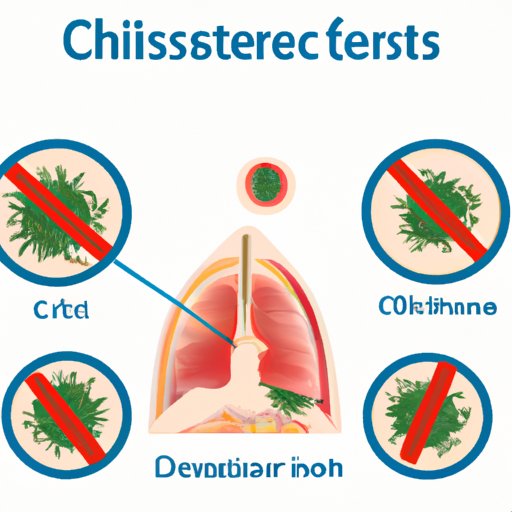
Introduction
A chest infection occurs when the lungs become infected, leading to inflammation of the airways and lung tissue. It can be caused by a virus, bacteria, or other microorganisms, and can range from mild to severe.
Identifying chest infection symptoms early on can help with prompt diagnosis and treatment, preventing the condition from worsening and causing further complications.
A Comprehensive Guide to Identifying Chest Infection Symptoms
There are different types of chest infections, each with their own set of symptoms. However, some of the most common symptoms include coughing, shortness of breath, chest pain, and fatigue.
Types of chest infections include bronchitis, pneumonia, and tuberculosis, among others. Diagnosis is usually made through physical examination, chest x-rays, and laboratory tests.
Understanding the Signs and Symptoms of Chest Infections
It is important to differentiate between viral and bacterial chest infections, as they require different treatments. Viral chest infections are usually self-limiting and can be managed with supportive care, while bacterial chest infections require antibiotics.
Factors that increase the risk of developing a chest infection include smoking, weakened immune system, prolonged exposure to polluted air, and pre-existing lung diseases.
Recognizing the Symptoms of Chest Infections – A Beginner’s Guide
Early symptoms of a chest infection include a cough, phlegm, shortness of breath, and chest tightness. As the infection progresses, symptoms can become more severe and include high fever, sweating, chills, and chest pain.
It is important to seek medical attention if chest infection symptoms persist for more than a week or if there is shortness of breath or difficulty breathing.
How to Detect a Chest Infection: A Step-by-Step Guide
Self-checks for chest infection symptoms can include monitoring temperature, cough, sputum production, and discomfort in the chest. Home remedies such as staying hydrated, getting enough rest, and using a humidifier can help manage mild symptoms.
However, if symptoms worsen, it is important to seek medical attention to prevent further complications.
Chest Infection Symptoms to Watch Out For
Symptoms that indicate more serious complications of a chest infection include confusion, rapid breathing, severe chest pain, and coughing up blood. Common complications include respiratory failure, sepsis, and pleurisy.
Prolonged or untreated chest infections can lead to permanent lung damage or death.
The Key Symptoms of Chest Infections and How to Manage Them
Strategies for managing chest infection symptoms include taking prescribed medications, staying hydrated, and getting enough rest. Some commonly prescribed medications for chest infections include antibiotics, bronchodilators, and cough suppressants.
Home remedies such as steam inhalation, using a humidifier, and drinking warm fluids can also help alleviate symptoms.
Everything You Need to Know About Chest Infection Symptoms
Identifying chest infection symptoms early on is crucial for prompt treatment and prevention of complications. Common symptoms include cough, phlegm, shortness of breath, chest pain, and fatigue.
Different types of chest infections require different treatments, and it is important to seek medical attention if symptoms persist or worsen. Home remedies and self-monitoring can help manage mild symptoms, but medical attention should be sought if symptoms worsen or persist for more than a week.





